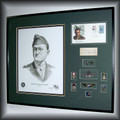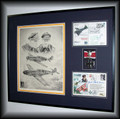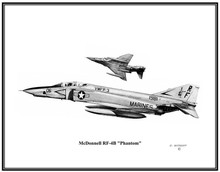 Loading... Please wait...
Loading... Please wait...Categories
Our Newsletter
- Home
- Combat Aircraft/Pencil Drawings ~ Free Shipping
- McDonnell RF-4B "Phantom" ~ Free Shipping
Product Description
***CLICK ON IMAGE TO ENLARGE***
Print Size 8½ x 11 ----- Unlimited print editionThe RF-4B was quite similar to the much more numerous RF-4C of the USAF. Like the RF-4C, the RF-4B was unarmed. The fighter's radar-equipped nose was replaced with a special nose specifically designed for reconnaissance applications. This nose was 4 feet 8 7/8 inches longer than the nose of the armed F-4B. The AN/APQ-72 radar of the F-4B was replaced by the much smaller Texas Instruments AN/APQ-99 forward-looking J-band monopulse radar which was optimized for terrain avoidance and terrain-following modes, and could also be used for ground mapping. There were three separate camera bays in the nose, designated Stations 1, 2, and 3. Station 1 could carry a single forward oblique or vertical KS-87 camera, Station 2 could carry a single KA-87 low-altitude camera, and Station 3 normally carried a single KA-55A or KA-91 high-altitude panoramic camera. The much larger KS-91 or KS-127A camera could also be carried. Unlike the cameras of the Air Force's RF-4Cs, the RF-4B's cameras were fitted on rotating mounts so that the pilot could aim them at targets off the flight path. The rear cockpit was configured for a reconnaissance systems operator, with no flight controls being provided. Two ALE-29A/B chaff/flare dispensers were installed, one on each side of the aircraft above the rear fuselage. For nighttime photography, a set of photoflash cartridges could be ejected upward from each side of the aircraft. An AN/APQ-102 reconnaissance SLAR was fitted, with antenna faired into the lower fuselage sides, just ahead of the intakes. This SLAR was capable of tracking both fixed and moving targets. An AN/AAD-4 infrared reconnaissance system was fitted in the fuselage belly just behind the SLAR. AN APR-25/27 radar homing and warning system was used, an ASW-25B one-way datalink was installed. An ALQ-126 deceptive electronic countermeasures package was installed, which obviated the need to carry external jammer pods. An ARC-105 communication transceiver was fitted, which required that large fin-skin shunt antennae be faired into both sides of the vertical fin. A Litton ASN-48 inertial navigation system was carried. The first 34 RF-4Bs retained the powerplants and the basic airframe of the F-4B. However, the last twelve were built with the wide wheels and the "thick" wing of the F-4J. The last three of these were completed with the smoothly-rounded undernose bulge similar to that seen on many USAF RF-4Cs. This adaptation improved the aerodynamics and increased the internal volume. However, on these three aircraft, the pilot no longer had control of the angle of a KS-87 camera on station 2, which was made fixed. The film could be developed in flight and film cassettes could be ejected at low altitude so that ground commanders could get aerial intelligence as rapidly as possible. The first RF-4B flew on March 12, 1965, and deliveries of 46 examples took place between May 1965 and December 1970. All of them went to the Marine Corps. The RF-4B was first delivered to VMCJ-3 based at MCAS El Toro in May of 1965, and soon after to VMCJ-2 at MCAS Cherry Point and to VMCJ-1 at Iwakuni in Japan. VMCJ-1 based at Iwakuni in Japan took its RF-4Bs to Da Nang in October of 1966. During the Southeast Asia conflict, three RF-4Bs were lost to ground fire and one was destroyed in an operational accident. Beginning in 1975, surviving Marine Corps RF-4Bs were upgraded as part of Project *SURE* (Sensor Update and Refurbishment Effort). There was some local strengthening of the airframe and the wiring was entirely replaced. These planes were fitted with the AN/ASN-92 carrier aircraft inertial navigation system (CAINS) which replaced the ASN-48. They were also fitted with the AN/ASW-25B datalink, the AN/APD-10B SLAR (replacing the APQ-102A), and the AN/AAD-5 infrared reconnaissance set (replacing the AN/AAD-4). Various externally-mounted electronic countermeasures pods were replaced by the internally-mounted ALQ-126 or -126B electronic countermeasures suite with characteristic cable ducts mounted on the sides of the intakes. The J79-GE-8 engines were later replaced by J79-GE-10 engines. In 1975, two years after combat in Southeast Asia had ended, the surviving RF-4Bs were regrouped into a new squadron, VMFP-3, based at MCAS El Toro. VMFP-3 stood down in August of 1990, bringing Marine Corps operations of the RF-4B to an end.








